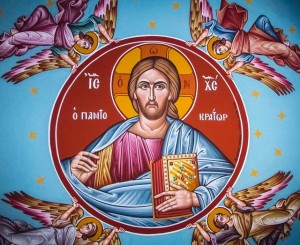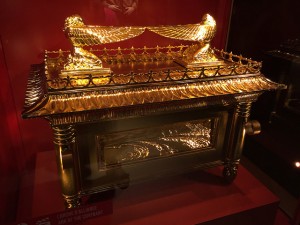 Why “Seated at the Right Hand of God”?
Why “Seated at the Right Hand of God”?
I’ve been back to blogging on the Heidelberg Catechism of late.
Recently I worked through what these 16th-century Reformed theologians thought about the Ascension.
In their line by line commentary on the Apostles’ Creed they took each obvious and not-so obvious issue in turn:
- Q46: What does Christ’s Ascension into heaven mean?
- Q47: Does that mean he’s not with us?
- Q48: Does that separate his humanity from his divinity?
- Q49: And, from a while back, how does this idea help us as Christians?
Then the writers move on to the Creed’s next line and ask
50 Q. Why the next words: “and is seated at the right hand of God”?
Good question, even if basically nobody is asking it today.
So, now that we are on the topic, why DOES the Creed say that?
The Easy Answer: The Bible Says So
I suppose the easiest answer is “Because the Bible says so.” Remember how Stephen, as the crowd pumelled him to death with stones, looked to heaven and said that he saw Jesus sitting there?
But filled with the Holy Spirit, he gazed into heaven and saw the glory of God and Jesus standing at the right hand of God.
‘Look,’ he said, ‘I see the heavens opened and the Son of Man standing at the right hand of God!’ (Acts 7:55-56)
Okay, I guess he got tired of standing there and sat down.
Actually most of the references refer to him sitting. (Matt. 26:64, Mark 14:62 & 16:19, Luke 22:69, Col. 3:1, Heb. 1:3, 8:1, 10:12 & 12:2)
And there is another simple answer: If he bodily rose from the grave and bodily ascended to heaven, he has to be bodily somewhere.
Complication: What is the Father Doing with Hands?
But then a different problem arises: God is not physical. God, according to Scripture, is Spirit, and by Church teaching the Father is not to be portrayed in physical ways.

You see this in the ancient Temple.
- The Holy of Holies was the definitive place where God chose to be present.
- It housed the Ark of the Covenant, holding the Ten Commandments.
- Two golden angel figures stretched out their wings above and across and the Ark, forming a kind of seat for God.
- The seat was, to all appearances, empty.
You would expect God to be sitting there on the, as it were, wing chair. But no.
And one of the commands on the tablets inside that Ark clearly forbade making any physical portrait of God.
So when the New Testament’s idea of the heavenly throne room, what is God doing with hands?
The trouble with the idea is called “anthropomorphism”: falsely attributing human characteristics to God. So there is a problem in the picture that the language of the Creed (and Scripture) creates.
(Though it does make room for the old joke about God being left-handed — since Jesus sat on God’s right hand.)
The Symbolic Answer: Christ Is Ruler of All
This word picture of God bodily occupying a physical throne room has to be symbolic language. It must point to a greater, invisible reality.
So here’s the Catechism’s take on the question:
A. Because Christ ascended to heaven
to show there that
he is head of his church,
the one through whom the Father rules all things.
Yes! The word picture of enthronement points, as a symbol, to a bigger truth. And it is an important reality:
Christ is large and in charge, the ruler of all, and especially the head of his Church — us.
This idea of Christ at God’s right hand is what you see portrayed inside the domes of countless Orthodox Churches: Christ “Pantokrator” or “Ruler of All.”
So when you say the Creed, or think about Christ after the ascension, remember that the imagery teaches us he is King of King and Lord of Lords — and let that fill you with trust and hope, whatever you are facing.
————
I’d love to hear your thoughts about Christ’s sitting at the right hand of God in the comments.
And if you enjoyed the post, please share it on Facebook or your favorite social media using the buttons below.

I’m really glad you connected it to a throne. One of my seminary professors said the same thing…it’s a royal image because kings sit. However, he also reminded us that a judge also sits when pronouncing judgment. Yikes!
Thanks Fr. Dustin!
Good point: kings sit and subjects stand — which reminds me of the long times people spend standing at prayer in Orthodox worship.
Thanks Gary this is the best explanation I have ever heard.
You always make me think.
Thank you so much Linda!
Thanks for this post.
There are beautiful resonances here with the enthronement Psalms — where God rules precisely because God is creator.
And these Psalms of enthronement dictate our response: praise and gladness and song because God is in charge — not the powers of this world.
Thank you for making this connection, Gary!
is there a verse in the bible which states the ark of the covenant was seen on the right hand of god
Thanks for stopping by, Debbie.
I don’t know of such a verse and a very quick online search did not turn one up.
In this article I was discussing the ark of the covenant as an illustration of the OT portrayal of God as absolutely not embodied — he has a throne (the ark) but is himself not physical (with hands).
I’m curious as to why it is written that Jesus sits at the right hand of God as opposed to at the right hand of the Father? We’re taught that God is a trinity, so how can Jesus be ‘next’ to God when He is in fact God Himself? Thank you and blessings. Jennifer
Hello Jennifer!
Thanks for posting this question. I don’t think we’ve met before, but if you are new to my blog I hope you’ll come back again soon. (I hope to return to the Heidelberg Catechism soon, actually. I have drafts of posts on the remaining Qs/As waiting for me…
In answer to your question, you are right. What you say agrees with the Creed. The original Latin of the Apostles’ Creed reads
“sedet ad dexteram Dei Patris omnipotentis”
which is
“sits at the right hand of God the Father Almighty.”
Back in Question 23, the Catechism quotes the Creed in its entirety and has that full line (both in the original German and the Latin of the same year), “sits at the right hand of God the Father Almighty. Here at Q. 50, the Catechism is commenting on every line of the Creed, and just points back to the line in shorthand.
There is a little bit more going on perhaps.
On the one hand, Christians in the West tend to be a bit sloppy about Trinitarian theology. Sometimes we slip into saying “God” for the First Person of the Trinity, almost as if we wouldn’t also say “God” for the Second Person and for the Third Person, and for the Trinity as a whole.
On the other hand, since the Three Persons are eternally distinct from each other, in relationship with each other, as well as being eternally One God, it is possible to speak of the Second Person “sitting” next to the First Person — though it is probably wise to acknowledge that the idea of them sitting involves a bit of anthropomorphism rather than a physical sitting.
But I think really they are just using a short form for what they’ve already written out in full.
All the best,
Gary
thank you brother for your insight.
But GOD is a real person. We are made in his image, and Adam and Eve walked with him daily.
Thank you for your commentary on Christ being at the right hand of GOD. Some people believe because of the Trinity, that we will only see GOD. Not Jesus too.
Thanks for your comments on this old post, Shirl.
It sort of depends on what you mean by “real person.”
Yes, God is real — actually more so than we are.
“God” is a term most clearly used of the Trinity — the “Godhead” as theologians often put it. Some tend to use “God” and mean “the Father” or “the First Person of the Trinity,” but it applies equally to the other Persons.
That is, God, the Holy Trinity, is eternally three “Persons” — the Father, the Son, and the Holy Spirit.
Each of these Persons is absolutely real, and is truly God.
the Father is God and is a real person;
the Son is God and is a real person;
and the Holy Spirit is God and is a real person.
This does not at all mean that each of them is human, with a body like yours and mine. We are made by God, the Trinity, in the image of God. That does not mean that our body looks like God or that our face looks like God’s face. Rather something more universal and fundamental about what we are, and what we are capable of doing, is rather more like what God is and what God does than anything else in creation.
God, the Son, the Second Person of the Trinity, came to us incarnate, the human person Jesus. The Son was already a Person but then that eternal divine Person “became flesh, and dwelt among us,” and was a human person like us but without sin.
Those words of the Creed about Christ at the right hand of God need to be understood to mean that Christ, the incarnate-and-now-human Second Person of the Trinity, truly God, ascended and now sits at the right hand of the Father, the equally God First Person of the Trinity.